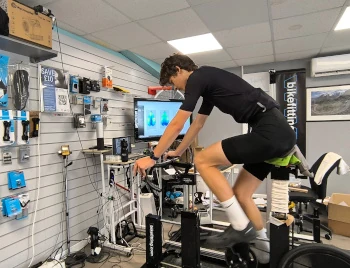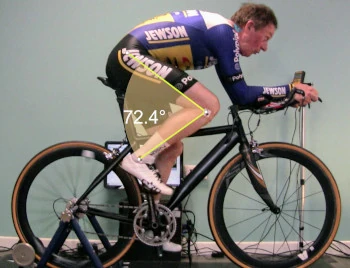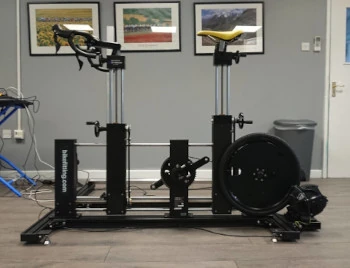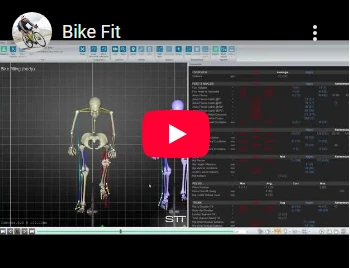Fit My Bike
At Fit My Bike, the final position that we arrive at is unique and bespoke to you.
Whilst some bike fit systems may position you based on the output from a series of body measurements, such as height and inseam. Or the results of measuring angles, such as knee and back, captured statically or even dynamically using sophisticated motion capture cameras, they aren’t the only thing to be considered.
Systems that use a series of standard algorithms to arrive at a position and are designed to work for the average person. This is great if you fall within their normative range, have maintained your flexibility and core strength and haven’t suffered any injuries or health problems.
There Are Many Bike Fit systems
 The ability to fit using standardised systems can help many cyclists. This allows relatively inexperienced bike fitters to come up with a satisfactory position in a short period of time. It’s like painting by numbers, keep moving the position until the light turns green. Job done. What happens if the position prescribed from these systems doesn’t work for you? Where does the fitter go next and why didn’t they try that during the process?
The ability to fit using standardised systems can help many cyclists. This allows relatively inexperienced bike fitters to come up with a satisfactory position in a short period of time. It’s like painting by numbers, keep moving the position until the light turns green. Job done. What happens if the position prescribed from these systems doesn’t work for you? Where does the fitter go next and why didn’t they try that during the process?
Motion Capture
This isn’t to say that there shouldn’t be a place for these systems. They do give a great starting point and are enough for many cyclists. Motion capture is an incredibly useful visual aid to help the cyclist view themselves on their bike and realise what is going on with their form. However, I’ve not seen one of these automated systems that asks the cyclist how they feel about the position and change it based on the feedback given.
Get in touch for more info
THE FITTING PROCESS
 The Fit My Bike fitting starts with an initial interview stage to find out what the cyclist wants to gain from the bike fitting session, what their cycling aspirations are and if there are any discomfort or other issues that they currently experience. Their equipment and current baseline position are examined and recorded as well as an assessment made of flexibility and muscle function. The actual pedalling starts a little way in to the process after plenty of time to warm up where an assessment is made of the current incoming position, motion capture and pedalling efficiency data is gathered that is reviewed together and a hypothesis made of what changes may be beneficial.
The Fit My Bike fitting starts with an initial interview stage to find out what the cyclist wants to gain from the bike fitting session, what their cycling aspirations are and if there are any discomfort or other issues that they currently experience. Their equipment and current baseline position are examined and recorded as well as an assessment made of flexibility and muscle function. The actual pedalling starts a little way in to the process after plenty of time to warm up where an assessment is made of the current incoming position, motion capture and pedalling efficiency data is gathered that is reviewed together and a hypothesis made of what changes may be beneficial.
Fittings take place on a professional fitting jig that enables rapid changes to be made and compared instantly. Try moving your saddle backwards and forwards on your bike and see how easy it is to recall and compare the previous position given the time to get off, undo the bolt, reposition, retighten and get back on. The process of changing the position is systematic and involves changing one variable at a time so that the cyclist gains an awareness of how that change affects them. The ability to feel the difference, with both positive and negative results are important. Until you know what you don’t like how do you know what you do like? Sometimes it comes down to the best compromise.
Professional Fitting Jig
 Once we’ve agreed that the position we’ve arrived at works for your needs we measure and record it and apply it as best as possible to the bike or look to see what a suitable new bike might be. This is the fun part particularly given the increasing complexity of integrated one-piece cockpits. I’d recommend getting the bike fit first before ordering that new bike with the expensive cockpit that can’t be changed without further expense. The final output from the session includes a drawing of the position that can be referred to as and when needed.
Once we’ve agreed that the position we’ve arrived at works for your needs we measure and record it and apply it as best as possible to the bike or look to see what a suitable new bike might be. This is the fun part particularly given the increasing complexity of integrated one-piece cockpits. I’d recommend getting the bike fit first before ordering that new bike with the expensive cockpit that can’t be changed without further expense. The final output from the session includes a drawing of the position that can be referred to as and when needed.
Available Time
The limiting factor within a bike fit is available time. There’s only so much we can get through in a session so experiencing what difference a change in crank length may make, trying different saddles out or installing wedges inside shoes may mean that you want to book a longer session or come back. We always aim to find a good position but the devil is in the detail and fine tuning.
Get in touch for more info
WHAT OUR CLIENTS SAY…
I've struggled for years getting comfortable - numb from an endless try of saddles, neck and back pain and aches through my hands.
Scott had a fantastic and detailed process and I felt instantly more comfortable just on his jig. His saddle fit and trial service is just utter genius. I was there the whole afternoon but at no point did Scott rush.
I've been back since for some other bits and will continue to use Scott for anything cycling related.
And today I went out for my first outside ride of the year and wow - I've never been so comfortable while I'm convinced I'm faster thanks to a better fit.
If you want to get more comfortable on a bike just book a slot with Scott, you won't regret it.
I have no doubt I’ll be much more comfortable and hopefully a lot quicker. I’ll happily recommend Scott to anyone wanting to get more out of their cycling.
Thanks again
As I didn't really experience issues on the bike I wasn't sure if I would benefit but the adjustments made have really be noticable in the few weeks since the fit! Makes you want to ride your bike even more! Highly recommended.
Mr Lawrence Lee
Headteacher


